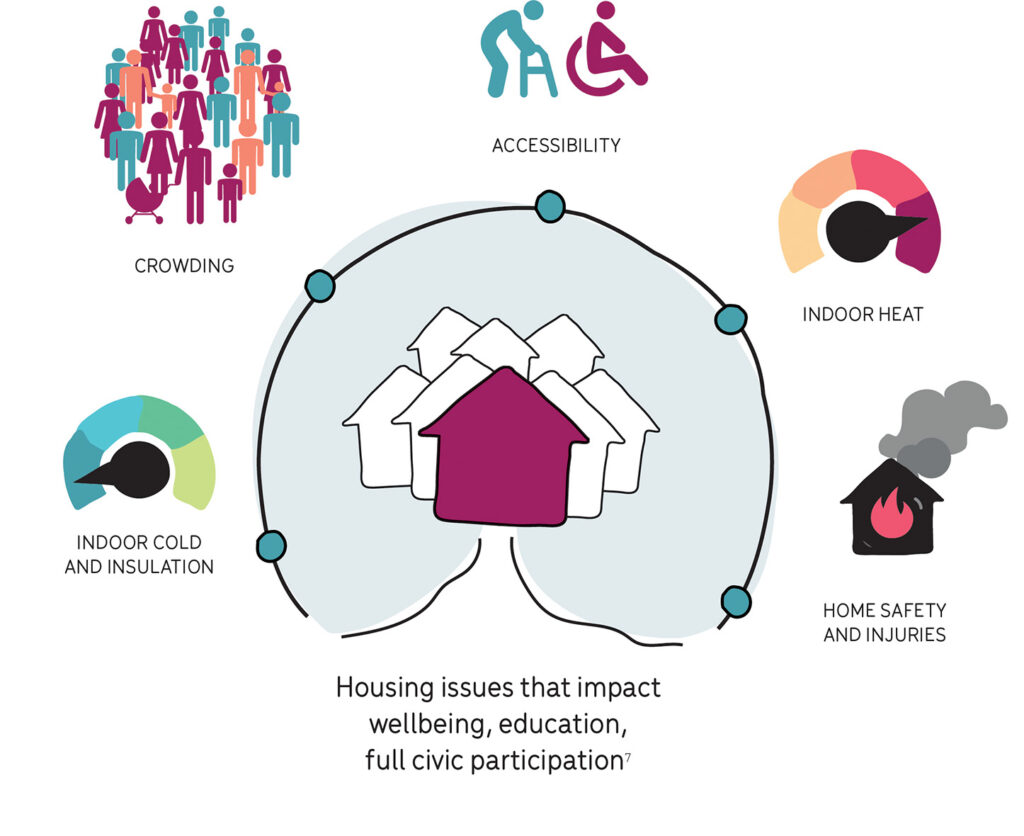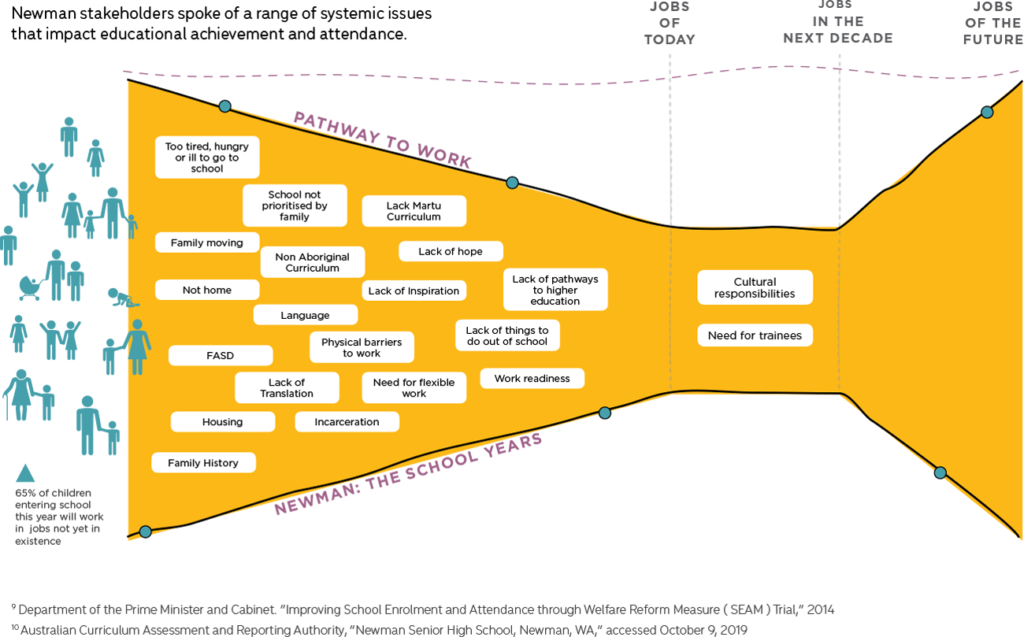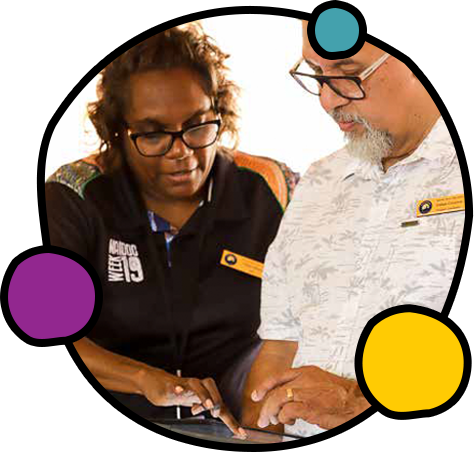Case for Change
Newman Futures was launched in 2019 to build a diverse and sustainable economy that is inclusive to all.


Through the development of the Newman Futures strategy in 2019, stakeholders emphasised the need for investment to support inclusive participation in the economy, aiming to redress inequality and catalyse a cultural and community renaissance in Newman through an inclusive digital economy.
Our consultation and engagement during this strategic development grew an understanding of the urgent need for action on key issues facing our society, such as climate change, social inequality, and economic instability. Newman Futures aims to inspire individuals and organisations to take meaningful steps towards a better future.

7 World Health Organization, xvii.
8 WA Country Health Service Planning and Evaluation Unit, “Pilbara Health Profile,” 2018
Housing
Housing is one of the biggest challenges in Newman and a focus for industry, government, NGOs and community. Access to quality housing is a top priority, but many homes are boarded up and unoccupied, which attracts vandalism.
East Newman has many damaged or empty homes and overcrowding is also an issue. In addition, there is a long waitlist for public housing, and there needs to be more appropriate housing for those seeking aged care.
The government must procure 73 houses by 2028 to accommodate an additional 365 Martu people in Newman. Investing $7.2 million in housing in the East Pilbara could save $12.7 million in avoided housing costs. Short-stay accommodation is also a priority for Aboriginal stakeholders to enable young people to stay in town for education.
There is a need for safe spaces for women and children. Suitable housing is crucial in preventing disease, reducing crime, reducing poverty, and increasing education and quality of life.
According to the Health and Housing Guidelines of the World Health Organisation, inadequate housing contributes to various problems experienced in Newman, such as indigenous imprisonment, decreased school attendance and achievement, illnesses, and increasing inequality.
Access to Health Care & Specialist Services.
While health data for Newman is challenging to access, Pilbara-wide data from the WA Country Health Services shows maternal health, chronic disease, mental health, and alcohol/drug diseases are areas of concern.
Across the Pilbara, 56% of Aboriginal women smoke during pregnancy vs 10% non-Aboriginal. In 2013, 21% of all teenage births in the Pilbara were to Aboriginal women. Feedback in 2019 also shows that Foetal Alcohol Spectrum Disorder and sexual health conditions are spiking in Newman.
Meeting health demands is critical for the local economy as more Martu families move in, with potentially many requiring specialist medical needs. Limited access to health care, particularly specialist services and maternity care, is a barrier to remaining in the town long-term.

Transitions from education to training and work.
The changing nature of work requires better education and training for all ages. The causal links between educational achievement and systemic neglect, disadvantage, and geographical isolation are profound and readily observed in Newman. Compared to Western Australia, fewer individuals achieve Year 12 or above education— only 41.1% of the Aboriginal population and 57.3% of the general Newman population complete Year 12 compared to a statewide average of 62.3%.
Policies such as SEAM and NAPLAN aim to improve attendance and testing9. However, Aboriginal students still need help with attendance and retention rates—only 11% of this cohort at Newman Senior High School attend 90% or more of the time10. Numeracy and literacy outcomes are low, and the transition between primary, secondary, and tertiary education needs strengthening. Stakeholders and teachers advocated more wide-ranging career aspirations for students in Newman.


Attraction and Retention of Staff
The Pilbara faces challenges in attracting and retaining quality staff due to unique conditions affecting the region’s sustainability and liveability. These include high living costs, transient communities, long travel distances, and gaps in service delivery11.
Technical skill requirements are the most common issue in other regions, but in the resource sector, access to adequately skilled workers is increasingly important due to advances in technology and innovation. The Newman Futures engagement process revealed that the attraction and retention of quality, skilled staff is a significant barrier across all industries, particularly for specialist roles such as teachers of specialised subjects. A strategic approach is necessary to promote job opportunities, employers, and the benefits of living in the Pilbara.
11 Peter Kenyon and Maria D’Souza, “Ten Year Community Plan for the Non-Government Organisations Sector in the Pilbara,”2016, 7-13
High Cost of Living and Doing Business
In 2011, the gap between the consumer price indexes in the Pilbara and metropolitan Perth was more significant than it is today. Nevertheless, the absolute level of costs in the Pilbara (particularly transport, construction, accommodation and wages) remains high and will continue to be so over the medium term12.
Further, cost multipliers indicate that the cost of some goods and services in Pilbara regional centres are now on par with Perth. Still, the Pilbara remains more expensive overall, and there is evidence that these costs are on the rise13.
12 Regional Development Australia (RDA) Pilbara, 513 Regional Development Australia (RDA) Pilbara, 5

Compared with Perth, operating a business of a similar type in any of the major Pilbara towns is very high, as shown above:


